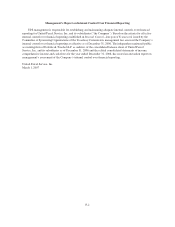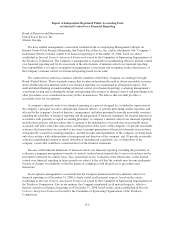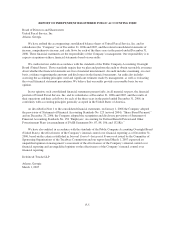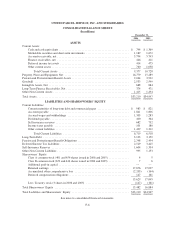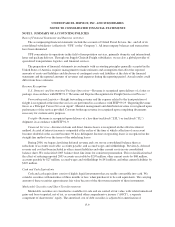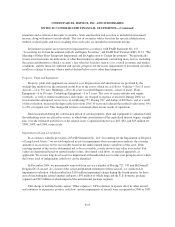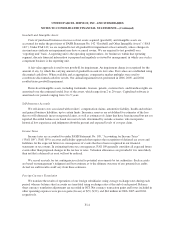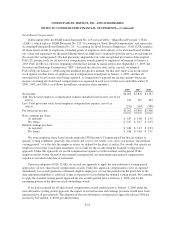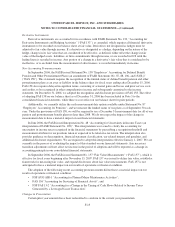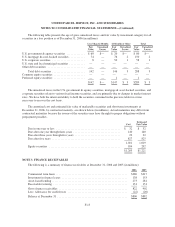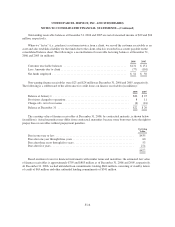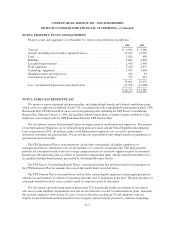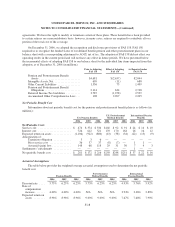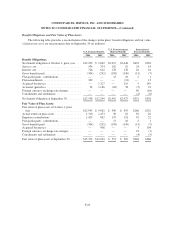UPS 2006 Annual Report Download - page 71
Download and view the complete annual report
Please find page 71 of the 2006 UPS annual report below. You can navigate through the pages in the report by either clicking on the pages listed below, or by using the keyword search tool below to find specific information within the annual report.UNITED PARCEL SERVICE, INC. AND SUBSIDIARIES
NOTES TO CONSOLIDATED FINANCIAL STATEMENTS—(Continued)
Goodwill and Intangible Assets
Costs of purchased businesses in excess of net assets acquired (goodwill), and intangible assets are
accounted for under the provisions of FASB Statement No. 142 “Goodwill and Other Intangible Assets” (“FAS
142”). Under FAS 142, we are required to test all goodwill for impairment at least annually, unless changes in
circumstances indicate an impairment may have occurred sooner. We are required to test goodwill on a
“reporting unit” basis. A reporting unit is the operating segment unless, for businesses within that operating
segment, discrete financial information is prepared and regularly reviewed by management, in which case such a
component business is the reporting unit.
A fair value approach is used to test goodwill for impairment. An impairment charge is recognized for the
amount, if any, by which the carrying amount of goodwill exceeds its fair value. Fair values are established using
discounted cash flows. When available and as appropriate, comparative market multiples were used to
corroborate discounted cash flow results. Our annual impairment tests performed in 2006, 2005, and 2004
resulted in no goodwill impairment.
Finite-lived intangible assets, including trademarks, licenses, patents, customer lists, and franchise rights are
amortized over the estimated useful lives of the assets, which range from 2 to 20 years. Capitalized software is
amortized over periods ranging from 3 to 5 years.
Self-Insurance Accruals
We self-insure costs associated with workers’ compensation claims, automotive liability, health and welfare,
and general business liabilities, up to certain limits. Insurance reserves are established for estimates of the loss
that we will ultimately incur on reported claims, as well as estimates of claims that have been incurred but not yet
reported. Recorded balances are based on reserve levels determined by outside actuaries, who incorporate
historical loss experience and judgments about the present and expected levels of cost per claim.
Income Taxes
Income taxes are accounted for under FASB Statement No. 109, “Accounting for Income Taxes”
(“FAS 109”). FAS 109 is an asset and liability approach that requires the recognition of deferred tax assets and
liabilities for the expected future tax consequences of events that have been recognized in our financial
statements or tax returns. In estimating future tax consequences, FAS 109 generally considers all expected future
events other than proposed changes in the tax law or rates. Valuation allowances are provided if it is more likely
than not that a deferred tax asset will not be realized.
We record accruals for tax contingencies related to potential assessments by tax authorities. Such accruals
are based on management’s judgment and best estimate as to the ultimate outcome of any potential tax audits.
Actual tax audit results could vary from these estimates.
Foreign Currency Translation
We translate the results of operations of our foreign subsidiaries using average exchange rates during each
period, whereas balance sheet accounts are translated using exchange rates at the end of each period. Balance
sheet currency translation adjustments are recorded in OCI. Net currency transaction gains and losses included in
other operating expenses were pre-tax gains (losses) of $(5), $(22), and $44 million in 2006, 2005 and 2004,
respectively.
F-11



